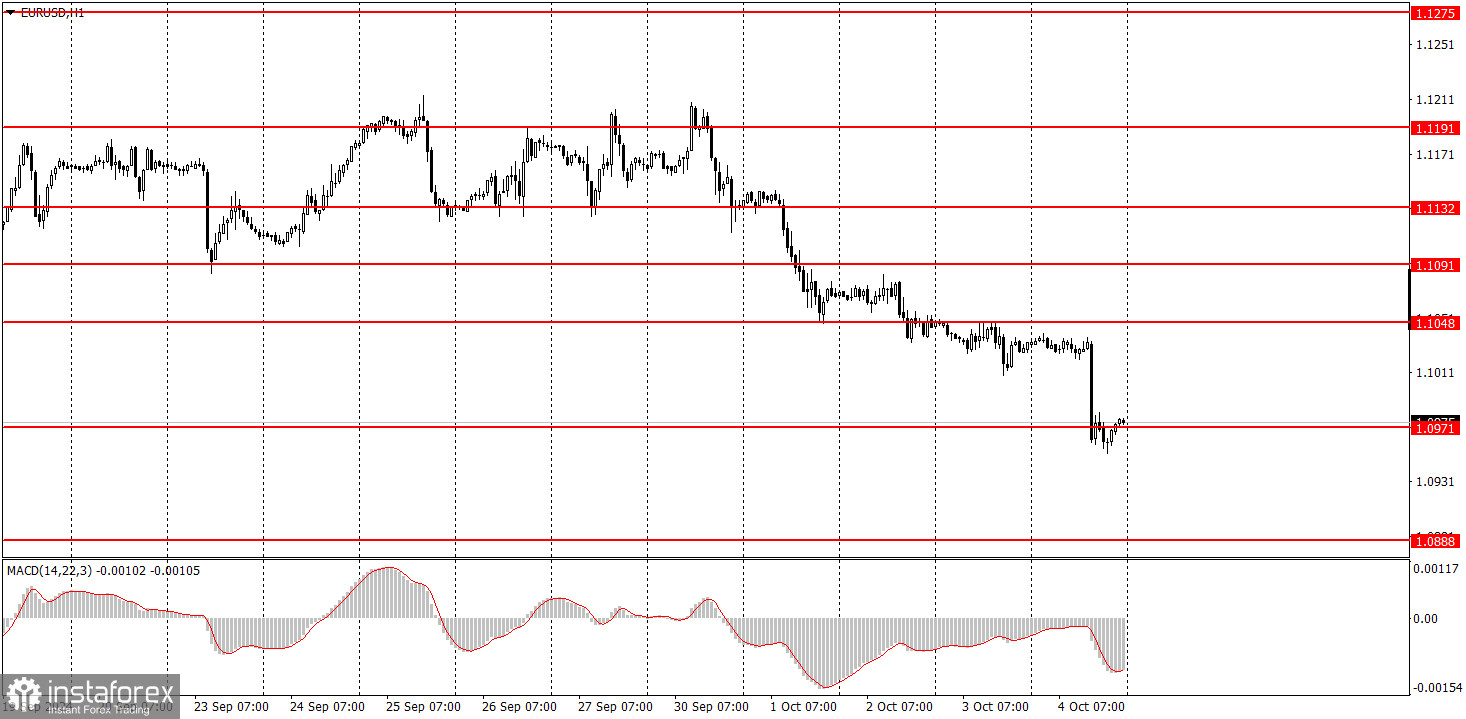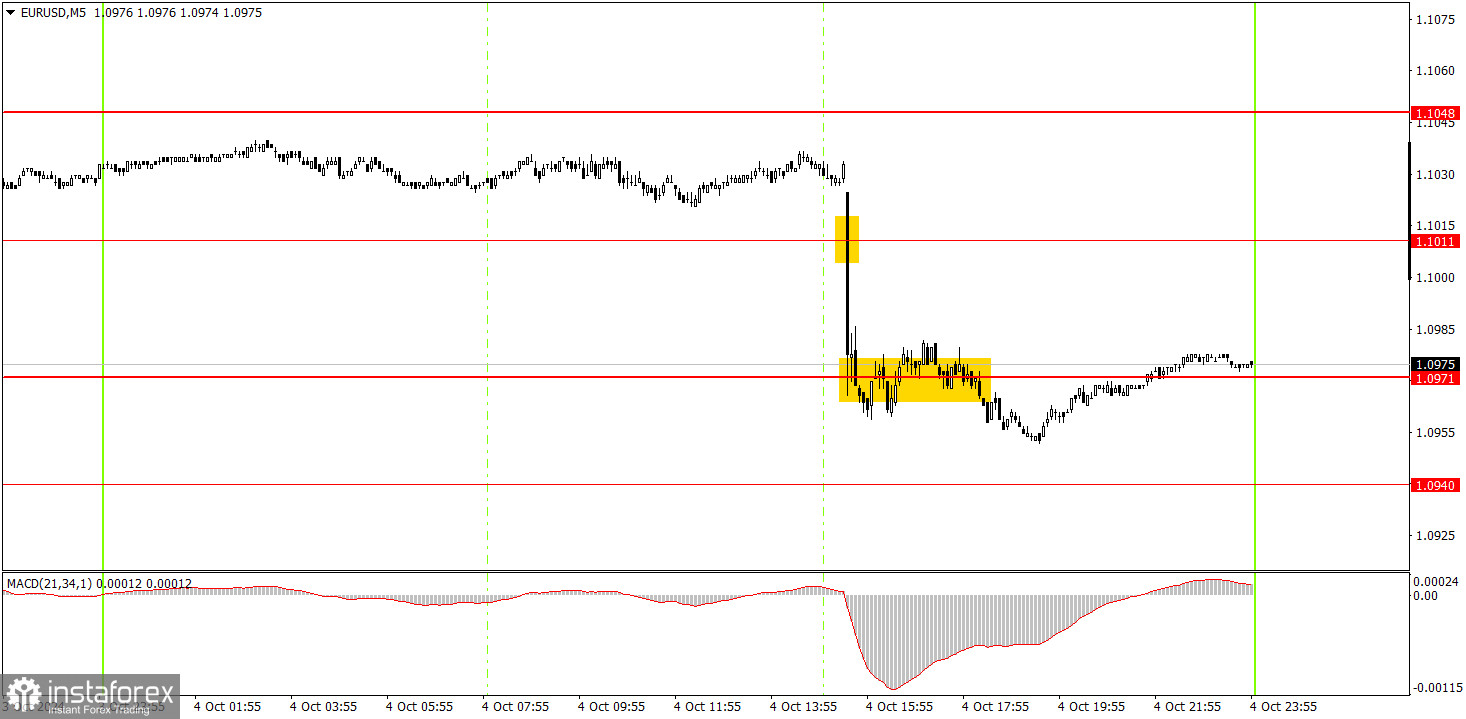Analysis of Friday's Trades:
1H Chart of the EUR/USD Pair

The EUR/USD currency pair resumed a strong decline on Friday, which had been ongoing throughout the week. Of course, the main and, essentially, the only reason for the rise of the US dollar on Friday was the macroeconomic data from the US, which the market had been anticipating since the start of the week. The NonFarm Payrolls report showed a result in September that was almost twice as high as forecasts, ending a period of weak job creation. At the same time, the unemployment rate fell to 4.1%, which the market did not expect. These two reports caused the dollar to rise again.
However, we want to remind you that the US currency remains undervalued and oversold overall. Thus, even without these reports, the dollar should rise, and the euro should fall. The market has been factoring in the Federal Reserve's monetary policy easing for two years now, while the fact that the European Central Bank has been lowering rates was largely ignored recently. But now, the situation is beginning to change.
5M Chart of the EUR/USD Pair

Two sell signals were formed in the 5-minute time frame on Friday. First, the price consolidated below the 1.1011 level, then broke through the 1.0973 level. However, these signals were challenging to execute. After the US reports were released, the price dropped by 65 pips in 5 minutes, so trading could only be done using pending orders. The second sell signal formed when the downward momentum had nearly exhausted.
How to Trade on Monday:
The EUR/USD pair moved significantly towards a downward trend this week in the hourly time frame. Unfortunately, illogical dollar sales could resume in the medium term, as no one knows how long the market will continue to process the Fed's monetary easing. However, at this time, there is a downward trend in the hourly time frame. After a correction, a further decline in the euro can be expected.
You can trade from the 1.0971 level on Monday. Since the euro has been falling for five consecutive days, a correction next week is quite likely, so be prepared for a slight increase.
In the 5-minute time frame, the following levels should be considered: 1.0726-1.0733, 1.0797-1.0804, 1.0838-1.0856, 1.0888-1.0896, 1.0940, 1.0971, 1.1011, 1.1048, 1.1091, 1.1132-1.1140, 1.1189-1.1191, 1.1275-1.1292. On Monday, the Eurozone will release a retail sales report, the only event on the first day of the new week. We can most likely expect relatively weak movements with a corrective bias.
Basic Rules of the Trading System:
- The strength of a signal is determined by the time it takes to form (bounce or break through a level). The less time it takes, the stronger the signal.
- If two or more trades were opened near a particular level based on false signals, all subsequent signals from that level should be ignored.
- In a flat market, any pair can generate a lot of false signals or none at all. In any case, it's best to stop trading at the first signs of a flat market.
- Trades should be opened during the period between the start of the European session and the middle of the US session, after which all trades should be manually closed.
- In the hourly time frame, it's preferable to trade based on MACD signals only when there is good volatility and a trend confirmed by a trendline or trend channel.
- If two levels are very close to each other (between 5 and 20 pips), they should be treated as a support or resistance zone.
- When moving 15 pips in the intended direction, a Stop Loss should be set to breakeven.
What's on the Charts:
Support and Resistance Price Levels: These levels serve as targets when opening buy or sell positions. They can also be used as points to set Take Profit levels.
Red Lines: These represent channels or trend lines that display the current trend and indicate the preferred trading direction.
MACD Indicator (14,22,3): The histogram and signal line serve as an auxiliary indicator that can also be used as a source of trading signals.
Important Speeches and Reports (always found in the news calendar) can significantly impact the movement of a currency pair. Therefore, trading should be done with maximum caution during their release, or you may choose to exit the market to avoid a sharp price reversal against the preceding movement.
For Beginners Trading on the Forex Market: It's essential to remember that not every trade will be profitable. Developing a clear strategy and practicing money management is key to achieving long-term success in trading.
 English
English 
 Русский
Русский Bahasa Indonesia
Bahasa Indonesia Bahasa Malay
Bahasa Malay ไทย
ไทย Español
Español Deutsch
Deutsch Български
Български Français
Français Tiếng Việt
Tiếng Việt 中文
中文 বাংলা
বাংলা हिन्दी
हिन्दी Čeština
Čeština Українська
Українська Română
Română

